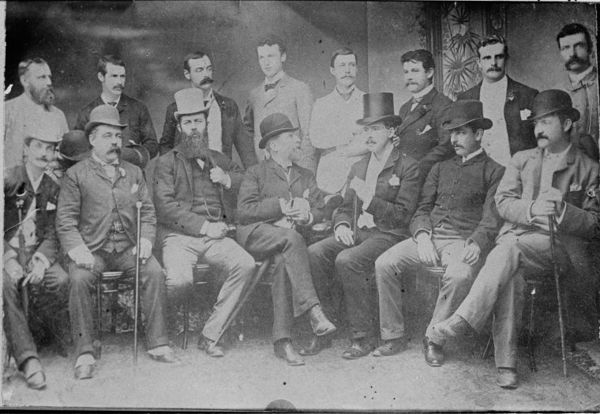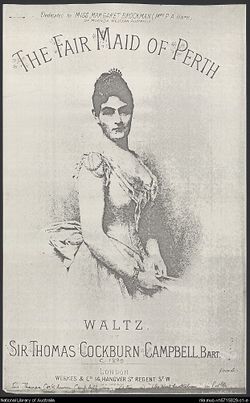Cockburn Campbell, Thomas - I21: Difference between revisions
No edit summary |
mNo edit summary |
||
| Line 26: | Line 26: | ||
| voyage_to_adelaide_in_1864= yes | | voyage_to_adelaide_in_1864= yes | ||
}} | }} | ||
Thomas Cockburn Campbell was born in Exeter, Devon in April 1845, the second son of '''Sir Alexander Thomas Cockburn-Campbell (1804-1871)''' and his second wife Grace, daughter of John Spence. | Thomas Cockburn Campbell was born in Exeter, Devon in April 1845, the second son of '''Sir Alexander Thomas Cockburn-Campbell (1804-1871)''' and his second wife Grace, daughter of John Spence. | ||
Revision as of 09:50, 19 September 2014
| {{safesubst:#invoke:br separated entries|main}} | |
|---|---|
| April 1845 – September 1892 | |
| First Class Passenger | |
| {{#invoke:InfoboxImage|InfoboxImage|image=Slwa b2976218 1 Sir Thomas Cockburn-Campbell-Crop.jpg|size=300px|sizedefault=frameless|alt=Sir Thomas Cockburn-Campbell|suppressplaceholder=yes}} Sir Thomas Cockburn-Campbell | |
| Place of birth | Exeter |
| Place of death | Perth, Western Australia |
| Nationality | |
| Occupation | Politician Newspaper Editor |
| Known for | First President of the WA Legislative Council President of the Perth Amateur Operatic Society |
| Title | 4th Baronet Campbell of Gartsford |
| Genealogy Data | |
| Person ID | I21 |
| Family ID | F41 |
| Spouse | Lucy Anne Trimmer (m.1870) |
| Children | 2 sons and 4 daughters |
| Voyage Data | |
| Role | First Class Passenger |
| {{safesubst:#invoke:br separated entries|main}} | |
Thomas Cockburn Campbell was born in Exeter, Devon in April 1845, the second son of Sir Alexander Thomas Cockburn-Campbell (1804-1871) and his second wife Grace, daughter of John Spence.
Early Life
Lieutenant-General Alexander Campbell (1760-1824), a Scotsman, had been created 1st Baronet Campbell in 1815 for his service and bravery in battles at Seringapatam, the Peninsular War, Gibraltar and Talavera. Because he had no surviving male heirs, special definition was granted in 1821 for him to be succeeded to the title by a grandson. His successor was Alexander Thomas Cockburn, first son of his daughter Olympia Campbell and her husband Alexander Cockburn. On becoming 2nd Baronet Campbell in 1824, he assumed the surname Cockburn-Campbell.
Tom Cockburn-Campbell was educated in England and at Heidelberg, and he travelled extensively in continental Europe. He spoke French fluently, and was said to have read more books in French than in English.
In Queensland he worked for six months as a chainman for the renowned explorers/surveyors, the Gregory brothers, and later with contractor surveyors. Sickness hindered his passing the examination to become a qualified surveyor, and in the late 1860s he went to Western Australia where his father was resident magistrate in Albany. In that colony he took up farming on a property near Mount Barker that he called Langton Park, after a Scottish village.
In May 1870 he married 20 years old Lucy Anne, daughter of Arthur Trimmer of Pootenup, near Cranbrook in a society wedding at the Old Residency in Albany. After the death of his father in April, closely followed by that of his elder brother Alexander less than five months later in September 1871, he suddenly found himself Sir Thomas Cockburn-Campbell (1845-1892), 4th Baronet Campbell of Gartsford.
Political Life
In 1873 he was nominated by Governor Weld as a member of the old partially-elected WA Legislative Council and he became chairman of committees in 1875.
He was a frequent contributor to the Western Australian Times, and he gave up farming in 1879 to settle in Perth. Entering a partnership with Charles Harper to purchase the newspaper, Cockburn-Campbell became managing editor. In a period of vigorous growth, it was renamed the West Australian, increased its size, came out three times weekly instead of twice, then became a daily in 1885.
Thomas maintained the newspaper’s campaign for self-government, but he tempered public agitation by advocating patience until the colony was ready to stand on its own two feet. He retired from the post of editor in 1887 due to ill health, but continued to write political articles for four more years.
In 1889 he was appointed one of the three delegates sent to London to put the case to the House of Commons for passing the Western Australia constitution bill. They were successful, and most of the credit was attributed to the impression made by Thomas Cockburn-Campbell.
In December 1890, after responsible government had been proclaimed, Thomas was appointed by the Governor to the new nominated WA Legislative Council, and was elected its first president.

Music
Sir Thomas composed a waltz "The Fair Maid of Perth" (1890) dedicated to Miss Margaret Brockman (Mrs P.A.Hare), published in London. [1] {{#ev:youtube|rizgeDPXUO8|240|right|"The Fair Maid of Perth" (1890).}}

{{#invoke: Gallery | gallery}}
Death
His health was becoming an increasing concern, and he was taking large doses of chlorodyne to help him sleep. He was found unconscious in the Legislative Council building in Perth one night in September 1892, and he died shortly afterwards, leaving his widow, two sons and four daughters. He was succeeded as 5th Baronet Campbell by his elder son Alexander Thomas Cockburn-Campbell (1872-1935).
Cockburn-Campbell was a serious and reserved man with few close friends, but he was kind and charitable and very encouraging of young people. He was President of the Perth Amateur Operatic Society, and he composed music as a hobby. As a journalist and legislator he was conservative, but he certainly earned the respect of the colonists.
Sources
Source : Australian Dictionary of Biography, O K Battye author.
Researcher
Researched by Ron Roberts, Adelaide, South Australia
References
{{#invoke:Navbox|navbox}}